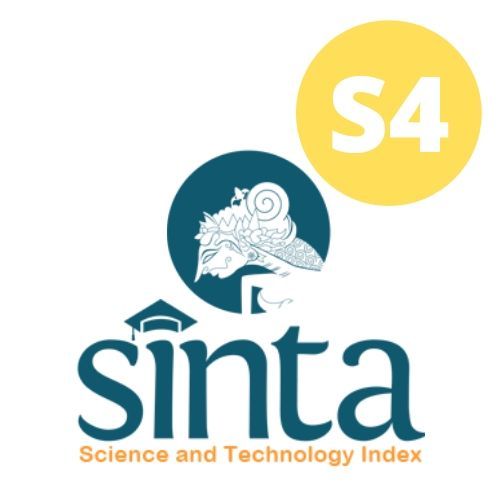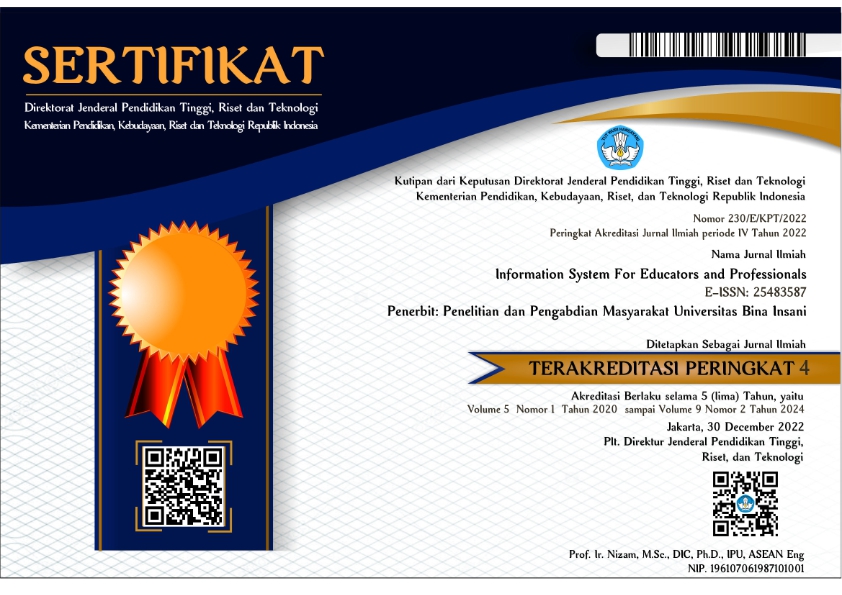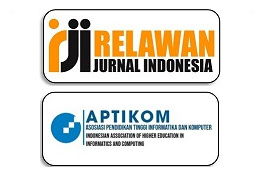Penerapan Particle Swarm Optimization Pada Algoritma Naïve Bayes Untuk Klasifikasi Hasil Belajar
Abstract
Advances in industrial technology 4.0 provide many changes in today's life. One example attached to the advancement of industrial technology 4.0 is the use of communication, transactions, even to the level of education using the acceleration of information technology. Some sectors have used advances in information technology such as the government sector, the industrial sector and even the world of education. This is because the greater the influence of the use of information technology to accelerate the transformation of each sector that uses it. But on the other hand, advances in information technology, apart from having a positive impact, also have a negative impact. As a real example of the positive impact, namely in the education sector, during the COVID-19 pandemic, the use of technology could be felt, as far as learning could be close to existing learning videos. However, one of the challenges is that advances in information technology also have a negative impact in the field of education, namely the dependence of students or students to spend more time playing online games (e-sports). So that it can affect the results of student learning achievement. Therefore, the research method that will be used is to use the classification of the influence of e-sports on student learning outcomes using the Nave Bayes algorithm which is optimized using particle swarm optimization. In its implementation, it was found that some students experienced decreased learning outcomes and some increased, of course this was influenced by several factors, both internal and external to the students themselves. The implementation of the algorithm used in this study obtained a sufficient level of classification with an AUC (area under classification) value of 0.792 and an accuracy value of 75.95%References
[1] Syamsuar and Reflianto, “Pendidikan dan Tantangan Pembelajaran Berbasis Teknologi Informasi di Era Revolusi Industri 4.0,†J. Ilm. Teknol. Pendidik., vol. 6, no. 2, pp. 1–13, 2018.
[2] A. Ginanjar, W. Purnama Sari, H. Rahmawati, and E. Dwipriyoko, “Metodologi RUP Terhadap Pengolahan Data Nilai Siswa Berbasis Android dan NodeJS,†J. TIARSIE, vol. 16, no. 4, p. 113, 2019, doi: 10.32816/tiarsie.v16i4.66.
[3] A. S. Permadi, A. Purtina, and M. Jailani, “Pengaruh Pemanfaatan Teknologi Informasi Dan Komunikasi Terhadap Motivasi Belajar,†Tunas J. Pendidik. Guru Sekol. Dasar, vol. 6, no. 1, pp. 16–21, 2020.
[4] H. Basri, “Implementasi Algoritma Naive Bayes Untuk Mengetahui Potensi Siswa Dalam Pemahaman Ms. Excel,†Sistemasi, vol. 8, no. 3, p. 505, 2019, doi: 10.32520/stmsi.v8i3.569.
[5] A. Syafi’i, T. Marfiyanto, and S. K. Rodiyah, “Studi Tentang Prestasi Belajar Siswa Dalam Berbagai Aspek Dan Faktor Yang Mempengaruhi,†J. Komun. Pendidik., vol. 2, no. 2, p. 115, 2018, doi: 10.32585/jkp.v2i2.114.
[6] I. K. Tojo and A. W. Widjaja, “Antecedents Dari Intention To Play Dan Pengaruhnya Terhadap Intention To Pay Pada Pemain Mobile Moba Games E-Sport Di Jakarta,†J. Ilm. Manaj. Ubhara, vol. 1, no. 2, 2019, doi: 10.31599/jmu.v1i2.675.
[7] K. Azwar, “Dampak Esport Game Terhadap Tingkat Emosiona dan Prestasi Belajar Remaja di Kota Lhoksumawe Provinsi Aceh Tahun 2020. STIKes Getsempena Lhoksukon,†J. Visipena, vol. 11, no. 2, pp. 255–265, 2020.
[8] Y. Suhanda, I. Kurniati, and S. Norma, “Penerapan Metode Crisp-DM Dengan Algoritma K-Means Clustering Untuk Segmentasi Mahasiswa Berdasarkan Kualitas Akademik,†J. Teknol. Inform. dan Komput., vol. 6, no. 2, pp. 12–20, 2020, doi: 10.37012/jtik.v6i2.299.
[9] H. Annur, “Klasifikasi Masyarakat Miskin Menggunakan Metode Naive Bayes,†Ilk. J. Ilm., vol. 10, no. 2, pp. 160–165, 2018, doi: 10.33096/ilkom.v10i2.303.160-165.
[10] Y. Ersan Fadrial, “Algoritma Naive Bayes Untuk Mencari Perkiraan Waktu Studi Mahasiswa,†J. Inf. Technol. Comput. Sci., vol. 1, no. 69, pp. 5–24, 1967.
[2] A. Ginanjar, W. Purnama Sari, H. Rahmawati, and E. Dwipriyoko, “Metodologi RUP Terhadap Pengolahan Data Nilai Siswa Berbasis Android dan NodeJS,†J. TIARSIE, vol. 16, no. 4, p. 113, 2019, doi: 10.32816/tiarsie.v16i4.66.
[3] A. S. Permadi, A. Purtina, and M. Jailani, “Pengaruh Pemanfaatan Teknologi Informasi Dan Komunikasi Terhadap Motivasi Belajar,†Tunas J. Pendidik. Guru Sekol. Dasar, vol. 6, no. 1, pp. 16–21, 2020.
[4] H. Basri, “Implementasi Algoritma Naive Bayes Untuk Mengetahui Potensi Siswa Dalam Pemahaman Ms. Excel,†Sistemasi, vol. 8, no. 3, p. 505, 2019, doi: 10.32520/stmsi.v8i3.569.
[5] A. Syafi’i, T. Marfiyanto, and S. K. Rodiyah, “Studi Tentang Prestasi Belajar Siswa Dalam Berbagai Aspek Dan Faktor Yang Mempengaruhi,†J. Komun. Pendidik., vol. 2, no. 2, p. 115, 2018, doi: 10.32585/jkp.v2i2.114.
[6] I. K. Tojo and A. W. Widjaja, “Antecedents Dari Intention To Play Dan Pengaruhnya Terhadap Intention To Pay Pada Pemain Mobile Moba Games E-Sport Di Jakarta,†J. Ilm. Manaj. Ubhara, vol. 1, no. 2, 2019, doi: 10.31599/jmu.v1i2.675.
[7] K. Azwar, “Dampak Esport Game Terhadap Tingkat Emosiona dan Prestasi Belajar Remaja di Kota Lhoksumawe Provinsi Aceh Tahun 2020. STIKes Getsempena Lhoksukon,†J. Visipena, vol. 11, no. 2, pp. 255–265, 2020.
[8] Y. Suhanda, I. Kurniati, and S. Norma, “Penerapan Metode Crisp-DM Dengan Algoritma K-Means Clustering Untuk Segmentasi Mahasiswa Berdasarkan Kualitas Akademik,†J. Teknol. Inform. dan Komput., vol. 6, no. 2, pp. 12–20, 2020, doi: 10.37012/jtik.v6i2.299.
[9] H. Annur, “Klasifikasi Masyarakat Miskin Menggunakan Metode Naive Bayes,†Ilk. J. Ilm., vol. 10, no. 2, pp. 160–165, 2018, doi: 10.33096/ilkom.v10i2.303.160-165.
[10] Y. Ersan Fadrial, “Algoritma Naive Bayes Untuk Mencari Perkiraan Waktu Studi Mahasiswa,†J. Inf. Technol. Comput. Sci., vol. 1, no. 69, pp. 5–24, 1967.
Published
2022-08-02
How to Cite
BASRI, Hasan et al.
Penerapan Particle Swarm Optimization Pada Algoritma Naïve Bayes Untuk Klasifikasi Hasil Belajar.
INFORMATION SYSTEM FOR EDUCATORS AND PROFESSIONALS : Journal of Information System, [S.l.], v. 6, n. 2, p. 97-106, aug. 2022.
ISSN 2548-3587.
Available at: <https://460290.0x60nl4us.asia/index.php/ISBI/article/view/1752>. Date accessed: 28 nov. 2024.
doi: https://doi.org/10.51211/isbi.v6i2.1752.
Section
Articles













